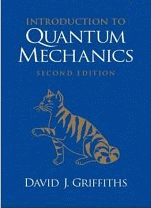 QUANTUM MECHANICS I
QUANTUM MECHANICS I
Spring 2007
Course description:
PHYS401 Quantum Physics I; (4 credits) Grade Method: REG/P-F/AUD.
Prerequisite: PHYS273.
Corequisites: PHYS374 and MATH240. Credit will be granted for only one of the following: PHYS401 or PHYS421. Formerly PHYS 421. Introduces some quantum phenomena leading to wave-particle duality. Schrödinger theory for bound states and scattering in one dimension. One-particle Schrödinger equation and thehydrogen atom.
0101(56013) Brill, D. (FULL: Seats=30, Open=0, Waitlist=0) Books
- M......... 3:00pm- 4:50pm (PHY 4208)
- W......... 3:00pm- 4:50pm (PHY 4208)
- F.........12:00om-12:50pm (PHY 0405) optional problem session
Instructor:
Dieter Brill
4202 Physics Building
(301) 405 6027
Office Hour: Monday 1-2p (not on April 9); Friday 12-12:50 room 0405 for problem session (not March 16)
Grader:
Adam Cohen
4219 Physics Building
(301) 405-6073
Office hours etc: see http://www.glue.umd.edu/~abcohen/.
YOU (students)
 Textbook:
Textbook:
Introduction to Quantum Mechanics by David J. Griffiths. This book has been used for this course for a number of years. The current edition is the second edition, whose preface reassures us that there are "as few changes [as possible], even preserving the numbering of problems and
equations, where possible". A used first edition will therefore be acceptable, recognized by the cat facing to the right, as at the top. If you don't have your book yet you can read the first 7 pages at Amazon, which opines
This book first teaches learners how to do quantum mechanics, and then provides them with a more insightful discussion of what it means.
Fundamental principles are covered, quantum theory presented, and special techniques developed for attacking realistic problems. The book's two-part coverage organizes topics under basic theory, and assembles an arsenal of approximation schemes with illustrative applications.
We may not strictly follow this two-pronged approach -- in other words, we may jump around in the book to some extent.
Exams, Homework
We will have a mid-term exam and a final exam, both lasting two hours, and counting approximately equally toward you final grade. You will also have homework, approximately weekly, counting 10-20% of the final grade (more detail to be posted later).
- The solution to the mid-term exam
- First assignment due Wednesday January 31
The numbers in [brackets] are those of the first edition
- Text, problem 1.3 [1.6] (p. 12) namely:
Consider the gaussian distribution,
ρ(x) = A e-λ(x-a)² ,where A, a, and λ are positive real constants. (Look up any integrals you need.)
- Use Equation 1.16 to determine A.
- Find <x>, <x²>, and σ.
- Sketch the graph of ρ(x).
- Text, problem 1.7 [1.12] (p. 18), to wit:
Calculate d<p>/dt. Answer: d<p>/dt= <-∂V/∂x>. This is an instance of Ehrenfest's theorem, which tells us that expectation values obey classical laws.
- Text, problem 1.16 (p. 22), which says:
Show that
for any two (normalizable) solutions to the Schrödinger equation, Y1 and Y2.
(In addition to the straightforward way, there is an elegant way of doing this using Eq 1.27 for Ψ1, Ψ2, and Ψ1+Ψ2 (resp. Ψ1+iΨ2) and the mathematical process of "polarization".)
- (not to be handed in) Read and understand -- ask questions if you don't -- p 64-65 of the text (probably around p. 46 in the first edition), which derives the formula for the group velocity we used without proof.
Second assignment due Wednesday February 7
Last assignment posted here, please make transition to Blackboard
More on Schrödinger's cat: See for example "practical applications" in the Wikipedia article.
- Operators (denoted here in bold face, A rather than by a hat, Â) form an algebra, that is, addition and multiplication of operators can be defined:
- Addition and multiplication by a number (such as i) is obvious. Calculate (x + ip)e−x². Suspend your natural suspicion of formulas that don't check dimensionally: we are using units in which G = 1 = c. (If you are wondering where such a strange operator can occur, look ahead at section 2.3.1. But don't look at Example 2.4!)
- Multiplication means performing the operations in succession, it may depend on the order. Calculate (x + ip)² as a differential operator, with all the derivatives standing on the right, that is, write it in the form A + B∂/∂x + C∂²/∂x²
- Define the parity operator P by Pψ(x) = ψ(−x) for an function ψ(x). What is the operator P²?
- Define the shift operator S by Sψ(x) = ψ(x−1). What is S³e−x²? In which direction does S shift, left or right?
- Suppose inverses of two operators A and B exist, for example A-1A = 1. Show that (AB)-1=B-1A-1. Note the order!
To illustrate, let A = putting on shoe, B = putting on sock, so (AB)(barefoot) = (foot with sock and shoe in proper order). Now think of the order in undoing this (AB)-1.
- Text, problem 2.2 [2.2]. Again there is also another way of doing this: Take the expectation value of Eq 2.5, integrate by parts.
- Text, problem 2.5 [2.6 modified]. The word "even" in the preamble is unfortunate. Griffith means the coefficients of ψ1 and ψ2 are equal -- not that Ψ(x,0) is an even function of x. In (c) you may of course use the result of Example 2.1. The P Lorre remark is only to remind you of the first part of Eq 1.33.
- Text, problem 2.38 [3.48]. So this is really a time-dependent potential, treated by the "sudden approximation."
Syllabus
My intent is to cover about half the material of the textbook (more than in the above "course description"). By the time of the mid-term exam we should at least have covered chapters 1 and 2 and some of the applications. I will post more details as we go along. In any case, the contents of the course -- and hence what is "fair" on exams" -- is defined by the lectures and homework, rather than by chapters in any one textbook.
Below is a list of the approximate textbook pages corresponding to exach lecture
| Lecture Date | | pages |
|---|
| January 14 | | deBroglie waves; 60, 64 |
| January 29 | | 1-5, 12-18 |
| January 31 | | 24-30 |
| February 5 | | 30-40 |
| February 7 | | 40-51 |
| February 12 | | 59-62, 70, 105 |
| February 19 | | 68-78 |
| February 21 | | 94-97 |
| February 26 | | 98-102, 106-107, 118-120, 122-123 |
| February 28 | | 103-105, 108-109 |
| March 5 | | 131-135 |
| March 12 | | 140-141, 160-161, 167-168 |
| March 14 | | 162-166, 136-138 |
| Match 26 | | Stuff not really in the book:
3D SHO, symmetry breaking by Bz,
mixing of states for time-dependent dipole moment |
| March 28 | | 140-145 |
| April 2 | | 146-150 |
| April 4 | | 151, 157-158, 201-202 |
| April 9 | | 299-300, 249-250 |
| April 11 | | 279, effect of finite-size nucleus |
| April 18 | | matrices |
| April 23 | | 257-261 |
| April 25 | | 171-180 |
| April 30 | | 181-184 |
| May 2 | | 185-188, 283-285 |
| May 7 | | 271-275 |
| May 9 | | 277-283 |
| May 15 | | Final Exam
1:30-3:30 pm PHYS1412 |
Applets: 1D infinite well see 1D Quantum Mechanics Applet
 Textbook:
Textbook: